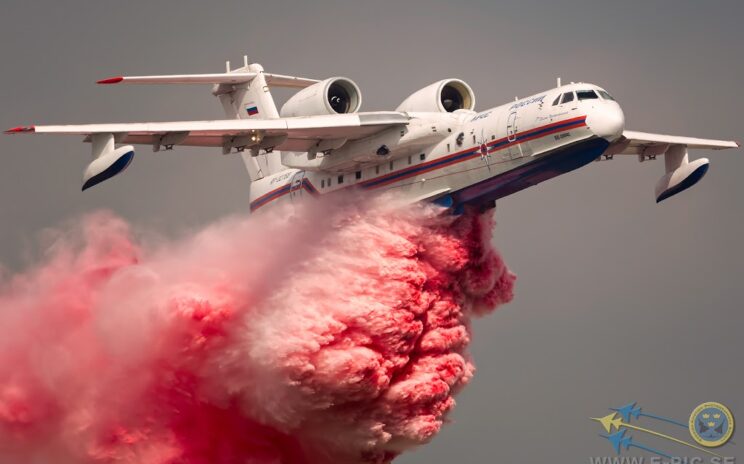Originally shared by +E-pic.se MAKS 2015 http://www.e-pic.se/Aircraft/Aircraft-sorted-by-type/Beriev/Beriev-Be-200-Altair/ The multirole Be-200 can be configured as an amphibious water drop fire-fighting aircraft, a freighter, or as a passenger aircraft—the pressurised and air conditioned cabin allowing transportation of up to 72 passengers. The Be-200 can also be equipped for special missions. When configured as an air ambulance, the aircraft can carry up to 30 stretcher patients and seven seated patients or medical crew. In the search and rescue role, the aircraft can be equipped with searchlights and sensors, an inflatable boat, thermal and optical surveillance systems, and medical equipment. The search and rescue variant can accommodate up to 45 persons. The aircraft is also capable of being configured for anti-submarine warfare duties.[1][13] The Be-200 fire-fighter suppresses fires by dropping water and/or chemical retardants. Eight ferric aluminium alloy water tanks are located under the cabin floor in the centre fuselage section. Four retractable water scoops, two forward and two aft of the fuselage step can be used to scoop a total of 12 tonnes of water in 14 seconds. Alternatively, the tanks can be filled from a hydrant or a water cistern on the ground. The water tanks can be removed quickly for carrying […]
Originally shared by +E-pic.se http://www.e-pic.se/Aircraft/Aircraft-sorted-by-type/Sukhoi/Sukhoi-Su-22M4/ The Sukhoi Su-17 / Su-22 (NATO reporting name: Fitter) is a Soviet variable-sweep wing fighter-bomber developed from the Sukhoi Su-7. It enjoyed a long career in Soviet, later Russian, service and was widely exported to Eastern Bloc, Middle Eastern air forces and Latin America as the Su-20 and Su-22. Seeking to improve low-speed and take-off/landing performance of the Su-7B fighter-bomber, in 1963 the Sukhoi OKB with input from TsAGI created a variable-sweep wing technology demonstrator. . A fixed inner wing simplified construction, allowing the manufacturer to retain the Su-7 landing gear and avoiding the need for complex pivoting underwing hardpoints, and it minimized the shift in the center of pressure relative to the center of mass with change in wing sweep. The new wing also had extensive leading-edge slats and trailing-edge flaps.The production aircraft was named Su-17 (NATO designation "Fitter-C") and was unofficially dubbed Strizh (Стриж, martlet) in service. Aside from the new wing, it differed from its predecessor Su-7 in having a new canopy and a dorsal fuselage spine for additional fuel and avionics. The Su-17 first flew on 1 July 1969 with E. K. Kukushev at the controls. A total of 2,867 Su-17 […]
What is your favorite aircraft if you could only pick one? In Album 11/2/15
Originally shared by +E-pic.se MAKS 2015http://www.e-pic.se/Aircraft/Aircraft-sorted-by-type/Sukhoi/Sukhoi-PAK-FA-T-50/ The T-50's design emphasizes frontal stealth, with RCS-reducing features most apparent in the forward hemisphere; the shaping of the aft fuselage is much less optimized for radar stealth compared to the F-22.[74] The combined effect of airframe shape and RAM of the production aircraft is estimated to have reduced the aircraft's RCS to a value thirty times smaller than that of the Su-27.[80] Sukhoi's patent of the T-50's stealth features cites an average RCS of the aircraft of approximately 0.1-1 square meters.[79] However, like other stealth fighters, the T-50's low observability measures are chiefly effective against high frequency (between 3 and 30 GHz) radars, usually found on other aircraft. The effects of Rayleigh scattering and resonance mean that low-frequency radars, employed by weather radars and early-warning radars are more likely to detect the T-50 due to its physical size. However, such radars are also large, susceptible to clutter, and are less precise. #Aviation #Aircraft #Sukhoi #PAKFA #Fighter #E_PIC_SE


